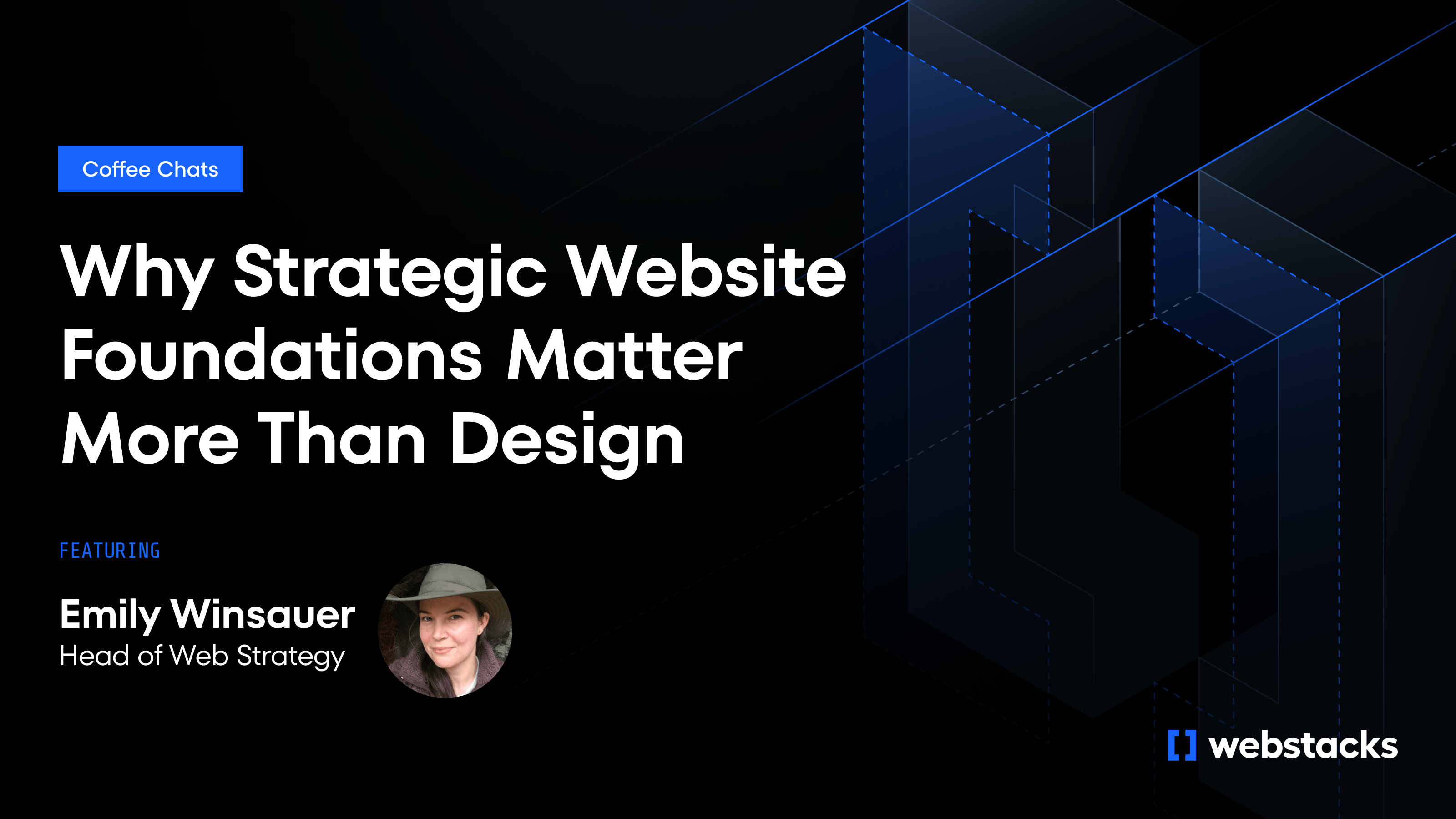Healthcare branding isn't just colors, logos, or taglines anymore. It also includes trust-building, digital performance, and clear communication with multiple audiences.
For growth-stage healthcare and MedTech companies, your brand is a system that powers how patients, providers, and partners experience your business online.
In a world where first impressions are increasingly digital, your website is central to delivering brand consistency at scale. Whether rolling out new products or navigating compliance challenges, a strong brand enables you to move fast.
However, building that brand requires the right strategy, systems, and digital infrastructure.
At Webstacks, we help healthcare marketing teams go beyond rebrands and redesigns. We build composable, modular websites that evolve alongside your business, so your brand doesn't just look great. It also performs.
This guide will explain the rules of healthcare branding and how to build a digital foundation that scales.

What Is Healthcare Branding Today?
Healthcare branding is the process of shaping how patients, providers, and partners perceive your healthcare or MedTech company across every touchpoint. It spans messaging, visual identity, digital experience, and overall trustworthiness.
Branding in healthcare has evolved from a visual identity exercise to a strategic pillar of business growth. Today, a healthcare brand must operate as a dynamic, cross-functional system that connects messaging, design, user experience, and technology.
Unlike traditional branding, which focuses on surface-level elements like logos and brochures, modern healthcare branding must account for the following:
- Multi-stakeholder communication: Messaging must resonate with patients, providers, payers, and even internal teams, sometimes all on the same page.
- Digital-first interactions: Most healthcare discovery, research, and decision-making now happen online. Your website, patient portals, and mobile experiences are your brand.
- Regulatory and compliance complexity: Consistency must also meet accessibility, HIPAA, and other compliance standards, without sacrificing flexibility or speed.
Too often, brands in this space fall into the trap of fragmented messaging, outdated assets, or rigid systems that can't support evolving business needs.
That's why healthcare branding today must be approached holistically: not as a project, but as a living system that adapts, scales, and performs.
For example, our approach to branding is to treat it as an operational framework that supports GTM velocity, CMS modernization, and cross-functional collaboration.
A great example of this modern approach is our work with Curative.
As they pivoted from COVID-19 testing to preventive health insurance, we helped transform their website into a dynamic, multi-audience platform. It aligned brand messaging with user experience, SEO, and backend integration.
The result was a visual refresh that drove nearly 100% year-over-year traffic growth and reduced support costs—proving that healthcare branding, when built as a living system, can drive measurable business impact.
Here’s the revised section tailored for MedTech companies, with sharper focus on complex messaging, regulatory needs, and go-to-market velocity:
How to Create a Healthcare Branding Strategy for MedTech Companies
For MedTech brands, your product isn’t the only thing under scrutiny. Your brand is too.
Buyers, partners, and providers are evaluating whether they can trust you in a high-stakes, regulated space. A clear branding strategy helps with this.
1. Define Your Brand Positioning
Get clear on what you do, who you serve, and how you're different.
- Are you improving diagnostics, streamlining care delivery, reducing costs?
- Who’s your buyer: clinical leaders, payers, procurement teams?
Positioning should reflect your technical depth and business value without drifting into jargon.
2. Map Your Stakeholders
MedTech brands rarely speak to just one audience. You’ll need messaging that resonates with:
- Clinical users (who want outcomes)
- Executive buyers (who need ROI)
- Partners or payers (who care about integration, scale, and compliance)
Understand their goals and decision-making process. Build your brand around those touchpoints.
3. Build a Messaging Framework
Start with a core story—your mission, solution, and differentiators. Then adapt that story by persona, product, or channel while staying consistent. This is important for aligning your sales, marketing, and product teams.
4. Design a Scalable Visual System
Create a modular design system that can work across product UIs, pitch decks, documentation, and your website. Use atomic design principles so your visual identity stays consistent, even as you scale.
5. Document Brand and Compliance Standards
Your brand guidelines should go beyond tone and color. Include accessibility (WCAG), regulatory considerations, and brand guardrails for clinical claims or data representation. This keeps your content compliant and on-brand, especially when multiple teams contribute.
6. Operationalize Through Systems
Bake your brand into your CMS, component library, and marketing workflows. It reduces dependency on design/engineering and enables faster launches when you’re rolling out new content or products.

Branding vs. Marketing in Healthcare
Branding and marketing work together, but they’re not the same thing. If you're building a MedTech company, knowing the difference helps you focus your time and resources where they’ll have the most impact.
Branding is who you are.
It defines your company’s identity, voice, and values. It answers:
- What do we stand for?
- Why should someone trust us?
- How should we show up across channels?
Branding sets the tone for every experience: on your website, in your product UI, in sales conversations, and in investor decks.
Marketing is how you tell your story.
It’s how you activate your brand through campaigns, content, ads, and outreach. Marketing is built on your brand and it takes your message to the right people, in the right places, with measurable results.
Why Healthcare Branding Matters for Growth-Stage Companies
For growth-stage healthcare and MedTech companies, branding accelerates GTM efforts, building trust in regulated environments, and aligning internal teams around a shared identity.
Here's how strategic branding drives impact:
- Speeds up product launches: A strong brand system creates templates for marketing new offerings without starting from scratch. Think modular design, structured CMS content, and a clear brand voice—built to scale.
- Builds credibility in competitive markets: Whether pitching to enterprise buyers or onboarding new providers, brand consistency creates trust.
- Connects complex messaging: Most MedTech companies must address multiple audiences, often within a single asset or experience. Brand frameworks help unify these messages.
- Differentiates in high-similarity verticals: Many healthcare solutions look and sound the same. Clear, consistent branding helps you stand out when features alone won't.
Why Your Healthcare Website Is the Frontline of Your Brand
Your website is the frontline of your healthcare brand because it’s where first impressions are made, trust is built, and business decisions are influenced.
A high-performing website should look polished and:
- Reflect your brand identity at every touchpoint, from homepage hero sections to CTAs, microcopy, and form experiences.
- Enable marketing agility through modular components and CMS flexibility, empowering non-technical teams to move fast.
- Deliver a unified experience across all audiences without content duplication or design drift.
- Support global or regional expansion with a scalable content architecture.
4 Key Elements of a Scalable Healthcare Brand
To build a healthcare brand that scales with your business, you need a system that enables your teams to execute consistently across websites, product lines, and marketing channels.
Here are the elements required to achieve this:
1. Unified Brand Voice
Your tone, language, and positioning should feel consistent whether someone reads a patient onboarding email, a provider partnership deck, or a careers landing page.
Establishing brand voice guidelines and operationalizing them in your CMS helps content creators stay on-brand without guesswork.
2. Design Systems Built for Speed and Accessibility
Atomic design methodology principles allow you to create reusable UI components that maintain brand integrity across hundreds of pages.
Paired with accessibility standards (WCAG, ADA), these systems ensure that your brand is consistent and inclusive.
3. Structured Content Models
With a modern CMS, you can define structured content types (e.g., provider profiles, care locations, clinical specialties) that are brand-aligned and easily reusable across regions or products.
4. Cross-Audience UX
Healthcare companies often face a three-way split: patients want easy access, providers need technical depth, and payers look for outcomes. A scalable brand enables personalized UX within one platform without fragmenting the visual identity or brand messaging.
When to Rethink Your Healthcare Brand (and How)
As your business evolves, your brand must keep up. But many companies don't realize they've outgrown their branding until it starts slowing them down.
Signs it's time for a brand rethink include:
- Your website no longer reflects your value prop or growth goals
- New product lines or service areas feel "bolted on"
- You're entering new markets or expanding globally
- Internal teams are building assets that look and feel off-brand
- Your CMS can't support the content velocity or personalization you need
Common branding triggers we see are:
- M&A activity or restructuring
- Market repositioning or targeting a new ICP
- Launching digital-first or self-service experiences
- Rebuilding your website or migrating your CMS
5 Common Mistakes in Healthcare Branding
Healthcare brands often aim for clarity and credibility, but end up with complexity and confusion. Here are the most common mistakes we see MedTech and healthcare companies make when building or evolving their brand:
1. Trying to Speak to Everyone at Once
When your messaging tries to cover patients, providers, partners, and payers all at once, it usually connects with no one.
Your brand should have one core story, with tailored layers for different audiences.
2. Leading With Features, Not Outcomes
Many MedTech brands focus on product specs or technical innovation. That’s important, but it’s not what drives decisions. Clear positioning should lead with business or clinical impact. Features support that story, not the other way around.
3. Inconsistent Visual and Verbal Identity
It’s easy for branding to drift when different teams build landing pages, sales decks, and support materials without a shared system. A lack of consistency weakens trust, especially in healthcare.
4. Ignoring Accessibility and Compliance
Branding that looks sharp but doesn’t meet accessibility (WCAG, ADA) or regulatory standards can slow you down later.
5. Treating Branding as a One-Time Project
Your brand isn’t static. As you launch new products, expand into new markets, or shift positioning, your brand needs to evolve too. Companies that treat branding as a one-off effort often end up redoing the same work later, just under immense pressure and with more complexity.
Branding Is Infrastructure—Build It to Scale
Healthcare branding is a strategic foundation for your company's growth. In today's digital-first environment, your brand needs to be modular, scalable, and built into your systems.
That means treating branding not as a static asset but as a digital infrastructure.
It should empower marketing teams, align cross-functional stakeholders, and support fast, compliant execution across every region, product line, and audience.
At Webstacks, we help MedTech and healthcare brands evolve quickly and confidently. Whether you're rebranding, rebuilding your website, or migrating to a modern CMS, we make sure you have the right foundations to succeed.
Let's build a digital foundation that evolves with your business.




